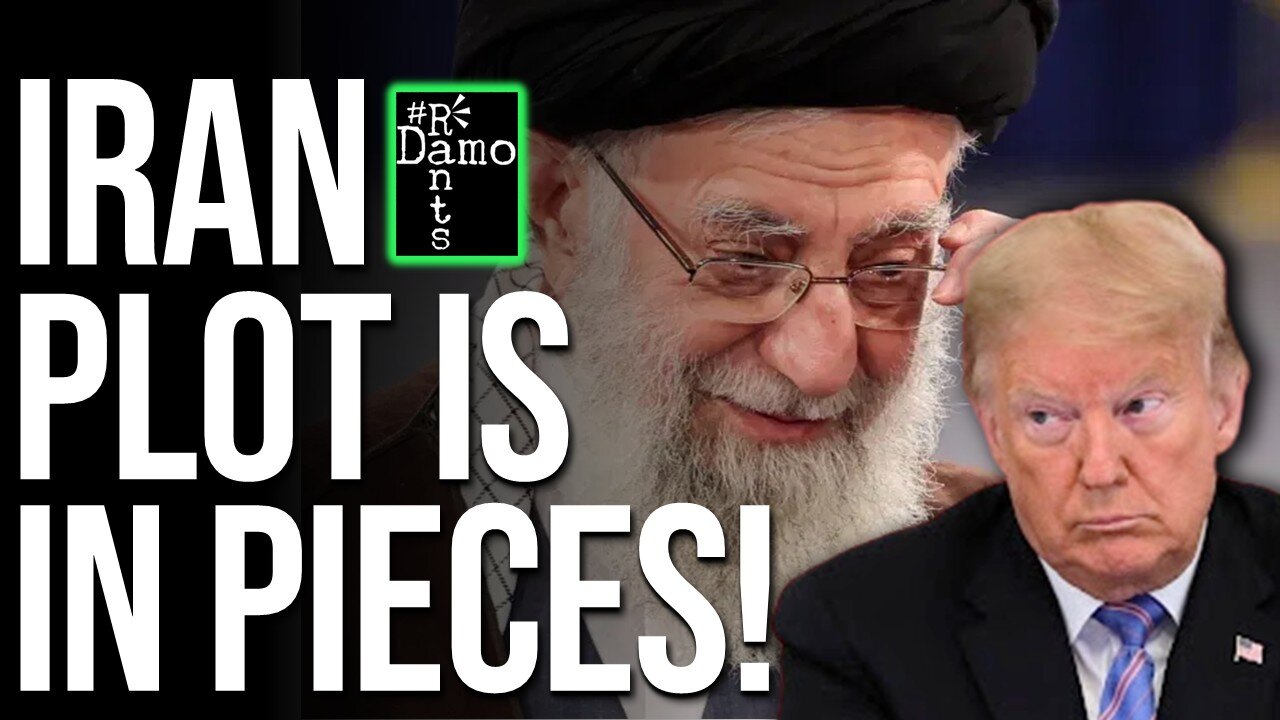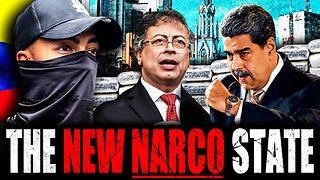Premium Only Content

Trump’s ‘Peace Corridor’ Just Triggered an Arms Race — And It’s Exploding
Right, so Donald Trump said he’d built a bridge of peace, and what he actually built was an arms market with a flag on it. The TRIPP corridor — his grand plan to join Armenia and Azerbaijan, box in Iran and call it diplomacy — has gone the way of every Trump deal before it: the photo survived, the peace didn’t. Within months of the signing, the two sides were buying jets from opposite sides of another diplomatic split, India and Pakistan were dragged into the fallout, and Iran, the country Trump swore to isolate, has ended up even stronger than when he started. The cameras caught a handshake; history caught a scam. This wasn’t peace through strength, it was profit through instability — a 99-year lease on chaos sold as vision, and another Trump instigated project that may have run its course, having run on headlines and little else.
Right, so Trump called it peace. The cameras caught the handshake, the flags, the podium, the promise of a corridor that would turn two old enemies into trading partners and show the world that American deal-making still ruled the map. Trump and his art of the deal. The ink was barely dry before the headlines declared it historic: Armenia and Azerbaijan signing a White House-brokered agreement to open a route through Armenia’s southern Syunik province, linking Azerbaijan’s mainland to its Nakhchivan exclave and on to Turkey. They called it the Trump Route for International Peace and Prosperity — TRIPP for short — a modern Silk Road with Trump’s name on it, his ego must be stroked at all times, but living up to the more literal definition of the word now, as the plan has tripped up and fallen on its face. Washington sold it as the moment the Caucasus would finally break its habit of war. But the habit didn’t break. It just shifted. Within months both sides were buying new aircraft, Iran was running drills on its northern border, and the map Trump claimed as his triumph had become the outline of another arms race.
Everything about TRIPP was built on imbalance. Armenia came to the table weakened, cut adrift from Moscow, far too preoccupied with Ukraine. Azerbaijan arrived emboldened, armed by Turkey, flush with energy money from selling its oil via Turkey to Israel, fresh from victory over Armenia previously. The deal that followed reflected that power gap: a corridor carved through Armenian soil giving Azerbaijan a direct road to Turkey and giving the US a permanent foothold in the one strip of land that still connected Iran to the Caucasus. On paper it was about trade and transit; in practice it was about control.
For Washington the purpose was simple: weaken Russia’s hold on Armenia and box Iran in from the north without firing a shot, just being there. Armenia’s Syunik province was the key — a mountain throat connecting four rival spheres of influence. Whoever ran that road ran the region’s logistics. Trump’s team dressed it in the language of prosperity and spoke about jobs, investment, tourism. But underneath was a ninety-nine-year concession granting American developers exclusive rights over infrastructure and communications. That’s not peacebuilding then is it? That’s a franchise.
Armenia didn’t sign because it trusted Trump. It signed because it had no one else. Russia’s CSTO umbrella had collapsed; the Kremlin was busy losing men in Ukraine and couldn’t spare them for Armenia. When Russian peacekeepers failed to protect Armenian villages in 2020, Yerevan learned that the alliance it paid for existed only on paper. So when the Americans turned up promising security through commerce, it looked like the last rope left to grab. They called it opportunity, but it felt like compulsion.
Azerbaijan saw something different: victory legitimised. Aliyev had wanted the Zangezur corridor for years — a land bridge from the Caspian to Turkey that bypassed Iran, who were closer to Armenia and charged Azerbaijan for the pleasure of crossing their territory. TRIPP gave him that in principle, wrapped in American prestige. He could sell it at home as diplomatic recognition of what his army had already taken by force. For Turkey it was the missing link in Erdogan’s Turkic world; for Iran it was seen as an existential threat. Within days Tehran condemned it, warning that any new route slicing Syunik from its borders would be met with force. Those weren’t empty words. Iran had spent years building its trade corridors through Armenia to Georgia and the Black Sea. Trump’s deal threatened to cut them off. So Iran started drilling troops near the Azerbaijani frontier and broadcasting the footage nationwide: proof, they said, that America’s peace meant encirclement.
Trump’s people called it self-sustaining peace — commerce that would make war unprofitable. But commerce only stabilises what power protects, and TRIPP removed the one power that had kept the front quiet. Russia pulled out, NATO stayed away, and the US offered nothing except contracts. So the vacuum filled the old-fashioned way — with weapons. Azerbaijan had signed for around forty JF-17 Block III fighters from Pakistan, and Armenia was negotiating a four-to-five-billion-dollar package with India for Su-30 MKIs. The so-called peace corridor became a live-fire insurance policy for two states that still didn’t trust each other enough to share a border crossing and Trump had of course gained the optics from the deal and therefore had lost interest in it afterwards.
Armenia’s pivot to India was born of desperation. It had nowhere else to buy from. The West talked democracy but sold nothing; Russia was unreliable; so Yerevan looked to New Delhi, which had already supplied Swathi radars and Pinaka rocket systems. For India it was a chance to project power into Eurasia and needle Pakistan at the same time. For Armenia it was life support. The contract debt alone will hang over its budget for a generation, but that was the cost of standing alone.
Azerbaijan answered the only way it knows — by doubling down. It deepened its “Three Brothers” pact with Turkey and Pakistan, turning that religious slogan into an arms pipeline. The new JF-17s came with Pakistani trainers and Chinese avionics; each delivery tethered Baku tighter to Beijing’s supply chain. Both sides believed they were buying security, but what they were really importing was dependency. The more they armed, the less sovereign they became.
Meanwhile Iran watched the pattern unfold and waited. They knew this wasn’t what Trump had planned, it bore keeping an eye on though. And it wasn’t long Iranian officials were already warning that the TRIPP corridor amounted to a Western military foothold near their border — a view echoed in regional analysis describing it as a “NATO-aligned presence” disguised as commerce. Tehran’s prediction proved accurate: the corridor never opened to trade. No roads were built, no customs union agreed, no observer mission deployed. The only traffic through Syunik was military. Iran used that failure as propaganda gold. What Trump had framed as the encirclement of Iran turned into Iran’s encirclement of the narrative. In Tehran’s telling, America had brought chaos to the Caucasus and left others to clean it up. For once, the evidence was on their side.
The further you trace the story, the clearer the design becomes. TRIPP was never built to last; it was built to announce. Trump needed a foreign-policy headline that sounded like victory over Iran without needing a war. A White House handshake did the job. The ninety-nine-year concession clause gave the deal an air of permanence, and initial US and regional coverage echoed Trump’s language of historic breakthrough. But the optimism faded quickly; soon there were reports from Yerevan and Baku describing implementation delays and growing unrest. Implementation was left to mid-level officials and private contractors whose only interest was the invoice. It’s the same pattern that ran through Doha 2020 and the North Korea summits: declare peace, withdraw, let someone else handle the collapse. What Trump sold as stability was really liquidation.
Months after the signing, the corridor existed only on paper. No construction tenders were published, no trade traffic reported, and the only movement through Syunik remained military. The “peace route” had yet to move anything except hardware and suspicion. By late 2025, Armenia’s opposition was already calling the TRIPP deal what it looked like — a surrender signed under pressure. In parliament and on the streets the argument was the same: sovereignty traded for a promise that never came. Azerbaijan’s answer was its own arms build-up, reading the same document as licence to push the advantage it already had. Along the Syunik route the corridor remained theory; no construction tenders, no trade convoys, only soldiers and drills. The United States set the conditions, called it peace through commerce, and left the region to carry the risk. It’s become a habit — replace security with contracts, treaties with concessions, and call it modern diplomacy. TRIPP proved the rule: America no longer builds order; it leases instability.
Once the ceremony faded, the only noise left was the sound of aircraft being bought on credit. The infrastructure never started, the trade never opened, but the weapons did. Armenia’s deal with India turned into its biggest defence purchase on record. Azerbaijan’s order from Pakistan turned what had been sold as a transport corridor into another front in South Asia’s cold war. Each side calls it deterrence; both know it’s debt. The route of prosperity has become a corridor of nerves.
Inside Armenia, people saw the shape of it before the diplomats did. The agreement that promised protection had written in a ninety-nine-year concession, and to most that sounded like ownership in disguise. Protesters in Goris and Yerevan spoke about land being leased out, because that was how it felt. The government tried to calm it with talk of jobs and American investment, but no cranes arrived, no roads were laid, no trade began. What arrived were payment schedules for aircraft still on Indian assembly lines. The corridor sold as peace has become a liability in the national accounts.
Across the border, Azerbaijan’s triumph was already souring as well. The new JF-17s flew well enough for the cameras, but they needed Chinese parts and Pakistani engineers to stay airborne. Each repair drew Baku further into dependence. Turkey had its corridor and its client, yet the victory was hollow: the road built to bypass Iran now relied on the instability that made it possible. The only constant in the story is the weapons trade.
Iran could afford to wait. Each month of inaction along the corridor made its earlier warnings look more credible. Iran has strengthened its north–south transport links, reopening road trade through Armenia to Georgia and deepening its role in the North–South Corridor with Russia. It has also signed fresh cooperation documents with China under their long-term partnership. The isolation that Washington planned for it has turned into leverage. The corridor meant to hem Iran in has created a ring of neighbours too armed, too indebted, and too divided to threaten anyone. Where the United States withdrew, Iran has still come out on top.
In Washington the language shifted again — from achievement to delay, from vision to technical issue. Nobody wanted to say what was obvious: the peace was never built because it was never designed to be. Armenia is squeezed between creditors and borders, Azerbaijan between its ambitions and the suppliers that feed them, and the region is still paying for what basically amounted to a photo-op.
That’s the real outcome. TRIPP didn’t fail, it revealed the template — American diplomacy as brand management, power outsourced to contractors, vision measured in airtime. The ninety-nine-year clause, the staged ceremony, the absence of enforcement: all of it theatre. When it faltered, there was nothing left to fix it, because the mechanism wasn’t policy, it was publicity.
Iran’s recovery from that chaos isn’t luck; it’s the basic physics of a vacuum. Russia has remained embedded in Armenia’s logistics network through its base at Gyumri and ongoing freight cooperation within the Eurasian Economic Union. It has also expanded joint transport projects with Iran along the North–South Corridor, which runs through Armenia. American concession turned toxic. Only the arms dealers remain, counting the same money under different flags.
The corridor was never built to connect; it was built to claim. It gave Washington a headline and left the region with a blueprint that bleeds. Armenia signed because it was cornered, Azerbaijan because it thought it had won, Trump because the cameras were rolling. The result is a strip of land where nothing moves except weapons and debt. This is how order fades — not with a war lost, but with responsibility handed off and forgotten. The TRIPP deal was meant to prove America could still draw lines that held; instead it proved how fast those lines dissolve when drawn for show. Armenia and Azerbaijan are arming again, Iran is stronger, and the corridor of peace exists only on paper. The documents tell the story if you read what’s missing. Nothing here collapsed by chance; it unfolded exactly as designed.
For more on this deal, only signed back in August and already falling apart, and the real reasons behind it, check out this recommendation here.
Please do also hit like, share and subscribe if you haven’t done so already so as to ensure you don’t miss out on all new daily content as well as spreading the word and helping to support the channel at the same time which is very much appreciated, holding power to account for ordinary working class people and I will hopefully catch you on the next vid. Cheers folks.
-
 32:09
32:09
ThisIsDeLaCruz
2 days ago $8.93 earnedFalling In Reverse: Christian Thompson’s Stage Tech Revealed
57.6K12 -
 LIVE
LIVE
Lofi Girl
3 years agolofi hip hop radio 📚 - beats to relax/study to
169 watching -
 18:03
18:03
Nikko Ortiz
2 days agoEBT Meltdowns Are Insane...
60.7K144 -
 2:02:46
2:02:46
Badlands Media
1 day agoDevolution Power Hour Ep. 405: Live from Cocoa Beach
203K74 -
 1:33:56
1:33:56
Man in America
12 hours agoElon Says the Quiet Part Out Loud: AI Will RULE Humans, No More Money, BILLIONS of Robots
62.8K66 -
 51:25
51:25
The Connect: With Johnny Mitchell
13 hours ago $35.08 earnedInside The REAL Narco State: The Colombian Drug Cartels DOMINATING The Global Cocaine Trade
40.7K18 -
 3:57:53
3:57:53
MattMorseTV
11 hours ago $122.50 earned🔴Saturday Night NEWS + DRAMA.🔴
117K105 -
 2:02:09
2:02:09
BlackDiamondGunsandGear
13 hours agoAfter Hours Armory / Leaked GLOCK images / Gunderware
34.3K6 -
 6:19:17
6:19:17
SpartakusLIVE
11 hours agoSaturday SPARTOONS || WZ to Start - REDSEC or ARC Later???
38.4K2 -
 19:23
19:23
Clintonjaws
1 day ago $22.91 earnedKaroline Leavitt STOPS Trump's Meeting & Grills Reporters Leaving Them Speechless
46.4K54